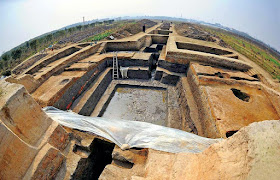So the LORD scattered them abroad from thence upon the face of all the earth:
and they left off to build the city.
Genesis 11:8
"A system of dams, levees and ditches discovered in China’s Yangtze Delta, dated 5,100 years old, may be one of the largest hydraulic engineering projects of its kind in the ancient world.
An international team, including researchers from Peking
University, discovered the 300-hectare complex using a combination of remote sensing, archaeological surveys and excavations that uncovered both large-scale earthworks and smaller scale features such as sandbags made of clay wrapped in grass leaves.
University, discovered the 300-hectare complex using a combination of remote sensing, archaeological surveys and excavations that uncovered both large-scale earthworks and smaller scale features such as sandbags made of clay wrapped in grass leaves.
The hydraulic engineering endeavor would have supported the densely populated city of Liangzhu and its intensive rice-farming economy that was highly dependent on often-unpredictable monsoon rains.
Researchers estimate that construction of the structures would have taken thousands of laborers around eight years to move nearly three million cubic meters of earth. They believe the system endured for 600−700 years. The Liangzhu culture represented a peak of early cultural and social development predating the historically recorded Chinese dynasties....a unique relationship between ritual order and social power is seen in the renowned jade objects in Liangzhu elite burials.
Wittfogel was among the first to explicitly to propose a formal
“hydraulic hypothesis”, wherein the elites of Asian polities used water-control systems as a means to force their populations into labor against their own best interests, in essence creating despotic regimes in a model that he termed “Oriental Despotism.” This hypothesis has been elaborated and challenged by diverse scholars.
“hydraulic hypothesis”, wherein the elites of Asian polities used water-control systems as a means to force their populations into labor against their own best interests, in essence creating despotic regimes in a model that he termed “Oriental Despotism.” This hypothesis has been elaborated and challenged by diverse scholars.
Perhaps akin to the speed and scale of construction projects in modern-day China, ancient Liangzhu emerged as a radical creation, prompting unprecedented social and economic change.
According to our excavations at the dams of Liyushan, Laohuling, and Mifenglong, the low dams were built on swampy lands. The excavations revealed a bottom layer of iron-depleted whitish clay, caused by long-term inundation and leaching in water.
Atop this light clay layer, people had posed bundles of grayish clay wrapped by grass leaves resembling “sand bags”, arranged as an artificial layering before the main body of the dams, was constructed by another layering of piles of pure yellowish clay. Bundles of the yellowish clay as well had been wrapped by grass leaves in apparent sand bags.
The immensity and internal complexity of the hydraulic system and city at Liangzhu undoubtedly required
--advanced planning,
--design, and
--logistics in
--construction,
--operation, and
--continual maintenance.
The labor expended on each dam, canal, or other feature can be calculated numerically in terms of the person hours needed to move the volume (m3) of earth for each construction, with further
consideration for the tasks of initial source material removal, transportation to the desired destination, and final positioning into the construction outcome.
–0.07 ha at eastern Mojiaoshan contained 10,000–15,000 kg of preserved rice, and it may have held more when full.
The sprawling network of channels and canals functioned along with strategically positioned gates, piers, and other constructions in support of the rice-farming economy, transport of goods and people, trade partnerships, and other goals. The waterways allowed several economic advantages that we are just now beginning to trace. For example, our petrological and experimental studies confirmed that the stones used in the base of the Liangzhu city walls were quarried from the nearby mountains in the north and transported downstream into the city through the water system."
PNAS
consideration for the tasks of initial source material removal, transportation to the desired destination, and final positioning into the construction outcome.
Complexities in design and operation, however, tend to be more qualitative than quantitative, although they can be estimated or inferred through the numbers of functional features, levels of hierarchy in houses and burial goods, and awareness of the how the hydraulic enterprise related with the religious, political, and other aspects of ancient Liangzhu.
We estimated that 3,000 people worked for nearly 8 y to move ∼2.88 million cubic meters of earth when building the ancient dams at Liangzhu.
As a unified undertaking, the hydraulic enterprise brought benefits of supporting the rice farmlands and ability to feed the city’s population as a whole. Archaeobotanical studies have confirmed the dominant role of rice in the local diet. A storage pit of 0.06–0.07 ha at eastern Mojiaoshan contained 10,000–15,000 kg of preserved rice, and it may have held more when full.
The sprawling network of channels and canals functioned along with strategically positioned gates, piers, and other constructions in support of the rice-farming economy, transport of goods and people, trade partnerships, and other goals. The waterways allowed several economic advantages that we are just now beginning to trace. For example, our petrological and experimental studies confirmed that the stones used in the base of the Liangzhu city walls were quarried from the nearby mountains in the north and transported downstream into the city through the water system."
PNAS





